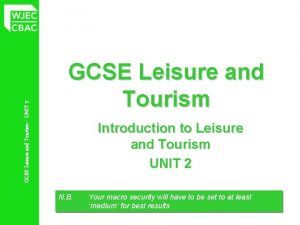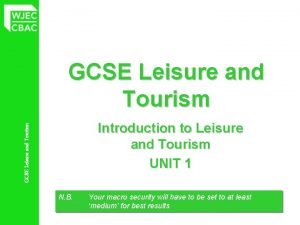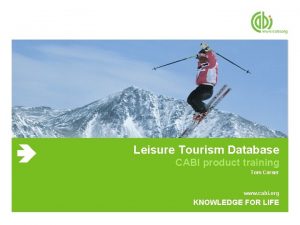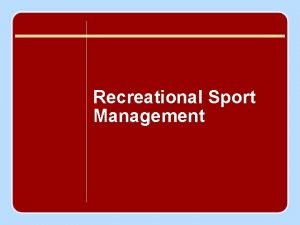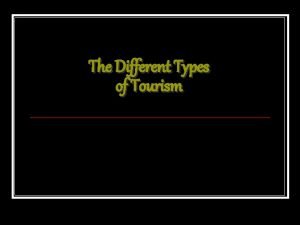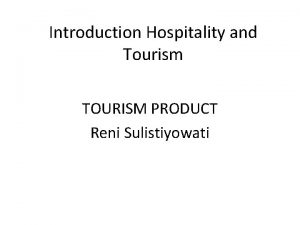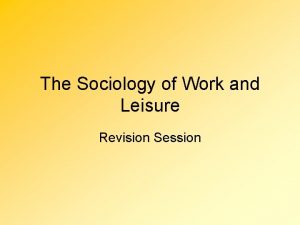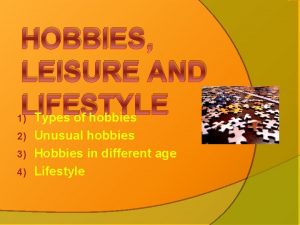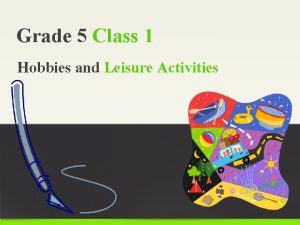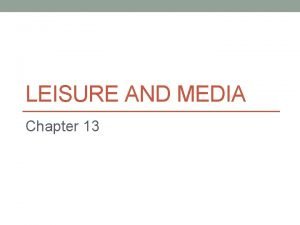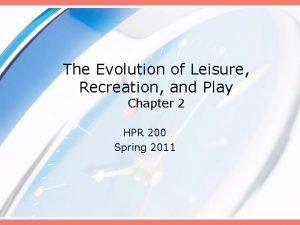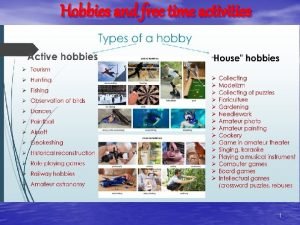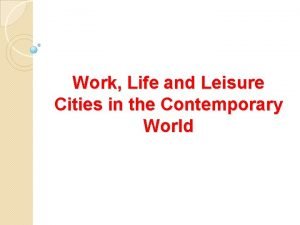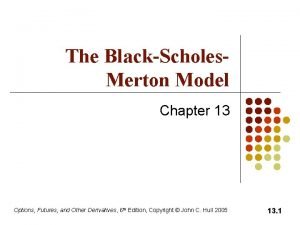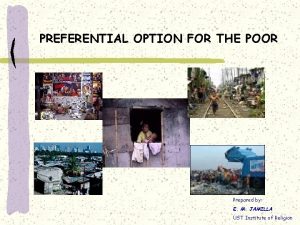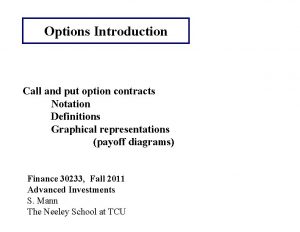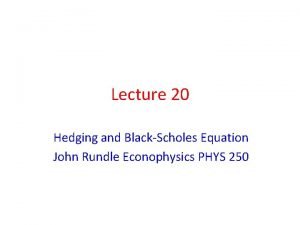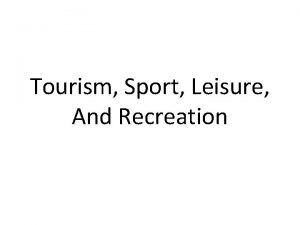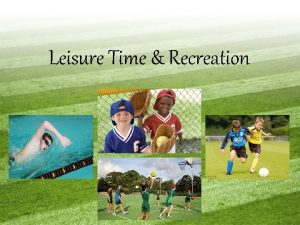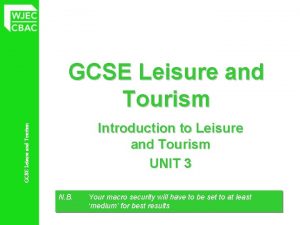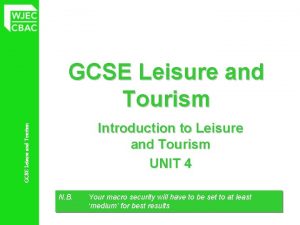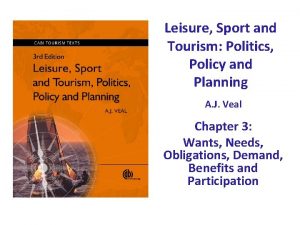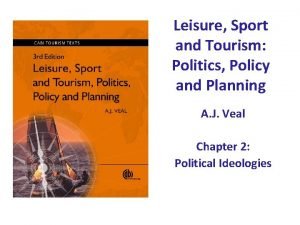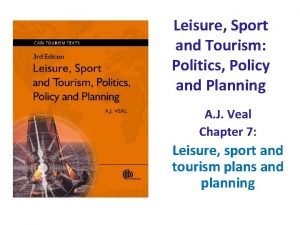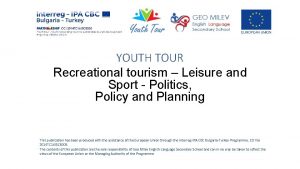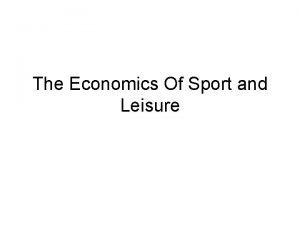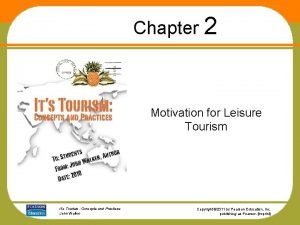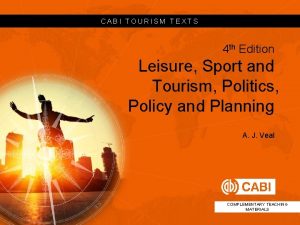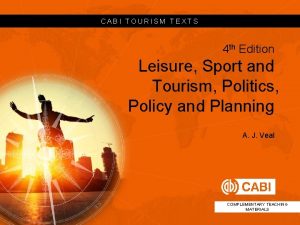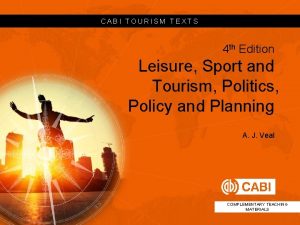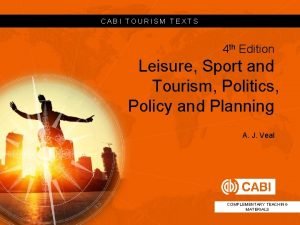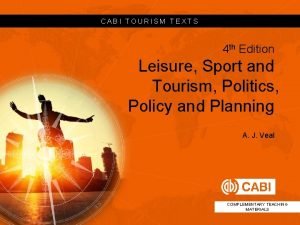LEISURE TOURISM AND SPORT OPTION E LEISURE Any










































- Slides: 42

LEISURE, TOURISM AND SPORT OPTION E

LEISURE Any freely chosen activity or experience that takes place in non-work time.

TOURISM Travel away from home for at least one night for the purpose of leisure.

SPORT Physical activities that involve using skills in events and competitions at the local, regional, national and international scales.

CHANGING LEISURE PATTERNS HOW HUMAN DEVELOPMENT ACTIVITIES PROCESSES GIVE RISE TO LEISURE • The growth and changing purpose of leisure time for societies in different geographic and developmental contexts • The categorization of touristic activities (cost, duration, destination) and sporting activities (cost, popularity, site) • The link between economic development and participation in leisure activities • Detailed examples to illustrate recent changes in participation for two or more societies at contrasting stages of development • Factors affecting personal participation in sports and tourism, including affluence, gender, stage in lifecycle, personality, place of residence

CHANGING LEISURE PATTERNS HOW HUMAN DEVELOPMENT ACTIVITIES PROCESSES GIVE RISE TO LEISURE • The growth and changing purpose of leisure time for societies in different geographic and developmental contexts Leisure may be defined in terms of time (free time), activities (thought of as “leisurely”) or states of mind (enjoyable, pleasurable activities). The range of leisure activities is expanding rapidly with the development of societies to support enthusiasts. Leisure includes hobbies. In the 18 OECD countries the largest proportion of their time is spent on personal care activities. Leisure is typically the second largest time category (22%). Leisure time is greatest in Norway (27%) and least in Mexico (16%). Continued….

The growth of leisure has been facilitated by: • a reduction in the length of the working day • a reduction in the length of the working week • an increase in wages • an increase in disposable income • the growth of leisure activities • an increase in people taking early retirement • an increase in self-employment and flexitime • development in technology (such as washing machines and agricultural machinery = more leisure time) and TV and the Internet (opportunities for leisure)

FACTORS AFFECTING THE GROWTH OF TOURISM Remember the growing grey market

The changing purpose of leisure time for societies in different geographic and developmental contexts: For many people in HICs and emerging economies, having more leisure time and greater disposable income allows them to take part in more leisure activities. However, in poorer countries, and in the countries where there is political turmoil, there is less opportunity for leisure activities, and not the “state of mind” of being “at leisure”. There is a link between income and leisure activities (particularly when it involves expensive equipment). Men generally have more leisure time than women (for household and parenting reasons). There are differences in culture. As life expectancy increases universally, pursuing leisure activities in retirement becomes more important.

CHANGING LEISURE PATTERNS HOW HUMAN DEVELOPMENT ACTIVITIES PROCESSES GIVE RISE TO LEISURE • The categorization of touristic activities (cost, duration, destination) and sporting activities (cost, popularity, site) • Skiing holidays are expensive while beach holidays may be cheaper because less specialist equipment is needed. • Large-scale tourism is a high-density form of tourism and holidays often last for between 7 and 14 days. This type of tourism is most frequently found in coastal areas, and is usually provided as a package holiday. • In contrast, ecotourism is generally a low-impact form of tourism and is associated with nature. • Some sport are very popular such as swimming, fishing and jogging. Some are very expensive such

PROCESSES The categorization of touristic activities (cost, duration, destination) and sporting activities (cost, popularity, site)

CHANGING LEISURE PATTERNS HOW HUMAN DEVELOPMENT ACTIVITIES PROCESSES GIVE RISE TO LEISURE • The link between economic development and participation in leisure activities - Level of income. In general, having a low income means that a person is less likely to engage in leisure activities that require significant expenditure of money, such as tourism, drinking and dining socially. - Car ownership has a significant impact on the type of leisure activities people engage in because personal mobility gives access to a wider range of recreational opportunities. - Working hours tend to be longer in poorer countries than in wealthier societies.

PROCESSES Leisure time for societies in different geographic and developmental contexts

ECONOMIC DEVELOPMENT AND PARTICIPATION IN LEISURE • Level of income (LICs: Less disposable income, therefore less chance of engaging in leisure pursuits like tourism, drinking and dining, particularly if expensive equipment is involved or tourism). • Car ownership (personal mobility gives access to a wider range of recreational opportunities). • Working hours (longer in poorer countries) • Indigenous populations (leisure activities include story-telling and music).

CHANGING LEISURE PATTERNS HOW HUMAN DEVELOPMENT ACTIVITIES PROCESSES GIVE RISE TO LEISURE • Detailed examples to illustrate recent changes in participation for two or more societies at contrasting stages of development (in Kindle). vs

CHANGING LEISURE PATTERNS HOW HUMAN DEVELOPMENT ACTIVITIES PROCESSES GIVE RISE TO LEISURE • Factors affecting personal participation in sports and tourism, including affluence, gender, stage in lifecycle, personality, place of residence • Affluence Most tourists and many participants in sport are affluent (in sporting venues, which generally charge an entry fee). • Gender There is a relatively low participation rate of Muslim women in athletics and swimming (and these receive much criticism at home).

Stage in lifecycle Younger people in wealthier countries tend to be less affluent than older people in the same countries, but they can nonetheless afford to travel. Enthusiastic and frequent tourists, low cost airlines, backpacking to exciting locations, booked by themselves online. Families. Popular destinations include beaches and other places where outdoor activities are possible, and in the case of more affluent families, ski fields. Middle-aged. The main motivations for middle-aged people to travel are to shop, to go to a beach, to swim or to visit culturally different places that are considered to be safe from crime and terrorism. Older tourists are less likely than younger travellers to make their own travel arrangements, often preferring to use travel agents. Group and package travel gives older people the confidence to travel to lesser-known destinations that offer new experiences and opportunities to learn about little-known cultures and places. Older people also travel extensively to spend time with family members. Golf was a top ten activity for all age groups in the UK except 16 -24 -year-olds for instance. Personality Some people prefer team sports while others may prefer more solitary sports such as running. Likewise, tourist destinations vary between those who prefer adventure, cultural heritage or “sun, sand sea”. Place of residence Many people who live in mountainous areas ski regularly, just as those who live in a coastal area may go surfing. Many people prefer to spend their holidays in a different type of environmenta to that in which they

TOURISM AND SPORT AT THE LOCAL AND NATIONAL SCALE HOW PHYSICAL AND HUMAN FACTORS SHAPE PLACES INTO SITES OF LEISURE • Human and physical factors explaining the growth of rural and urban tourism hotspots including the role of primary and secondary touristic resources • Variations in sphere of influence for different kinds of sporting and touristic facility, including neighbourhood parks and gyms, city stadiums and national parks • Factors affecting the geography of a national sports league, including the location of its hierarchy of teams and the distribution of supporters • Case study of one national sports league • Large-scale sporting, musical, cultural or religious festivals as temporary sites of leisure and their associated costs and benefits • Case study of one festival in a rural location, its site factors and geographic impacts

TOURISM AND SPORT AT THE LOCAL AND NATIONAL SCALE HOW PHYSICAL AND HUMAN FACTORS SHAPE PLACES INTO SITES OF LEISURE • Human and physical factors explaining the growth of rural and urban tourism hotspots including the role of primary and secondary touristic resources • Hotspots areas of intense sporting or leisure activity that attract above average numbers of visitors. • Primary tourist/recreational resources are the pre-existing attractions for tourism or recreation that have not been built specifically to attract tourists, including climate, indigenous people. • These are distinguished from secondary tourist/recreational resources, which include accommodation, catering, entertainment and shopping.

For a destination to become a tourist hotspot, several factors are required, including: • Appeal • Well-known (more marketing) • Accessible (airport, public transport) • Affordable (budget airlines) • Safe (no crime, terrorism or disease)

TOURISM AND SPORT AT THE LOCAL AND NATIONAL SCALE HOW PHYSICAL AND HUMAN FACTORS SHAPE PLACES INTO SITES OF LEISURE • Variations in sphere of influence for different kinds of sporting and touristic facility, including neighbourhood parks and gyms, city stadiums and national parks • The sphere of influence refers to the area from which a facility or an attraction draws its support. • A small playground may have a low threshold population (the minimum number of people needed to support a facility or service (like Boots at Bekkestua requires 10 000 residents) and a very small range (the maximum distance people will travel to visit a facility/service), hence it will have a small sphere of influence (catchment). In contrast, a national sports stadium or a multi-purpose arena (like Oslo Spektrum) will derive its support from a much wider area.


TOURISM AND SPORT AT THE LOCAL AND NATIONAL SCALE HOW PHYSICAL AND HUMAN FACTORS SHAPE PLACES INTO SITES OF LEISURE • Large-scale sporting, musical, cultural or religious festivals as temporary sites of leisure and their associated costs and benefits Large-scale sporting, musical, cultural or religious festivals have many costs but also many benefits. • Case study of one festival in a rural location, its site factors and geographic impacts There are nine annual festivals in Voss; however, the Extreme Sports Week is a unique and hybrid festival, steadily growing with a pronounced “leave no trace” philosophy and support for simple lifestyles. It indicates attempts to demonstrate festival sustainability in practice. It has been held annually for 20 years. Continued…

Possible benefits Extremveko Income Sports facilities like the wind-tunnel Concerts Community spirit Tourists 20 th anniversary in Wikipedia 2017 Possible costs Air pollution Voss Extreme Sports Week Ranked as Best in the World Waste disposal problems Celebration of Extreme Playfulness Noise pollution Congestion Provision of resources problems OR the Enga Cultural Festival in Papua New Guinea on 32% in your textbook.

TOURISM AND SPORT AT THE LOCAL AND NATIONAL SCALE HOW PHYSICAL AND HUMAN FACTORS SHAPE PLACES INTO SITES OF LEISURE • Factors affecting the geography of a national sports league, including the location of its hierarchy of teams and the distribution of supporters Most teams in the top league of their national sports derive from a wide area. Some clubs have a global following, although many of their fans can only follow their teams on television or the Internet. In contrast, lower league teams tend to have a smaller sphere of influence. They do not have the success to generate international (or even national) interest. Hence, their support is more localized. However, some fans move on to university or for a job, so the fan base may become broader.

TOURISM AND SPORT AT THE LOCAL AND NATIONAL SCALE HOW PHYSICAL AND HUMAN FACTORS SHAPE PLACES INTO SITES OF LEISURE • Case study of one national sports league The English/Welsh Football League

TOURISM AND SPORT AT THE INTERNATIONAL SCALE THE VARYING POWER OF DIFFERENT COUNTRIES TO PARTICIPATE IN GLOBAL TOURISM AND SPORT • Niche national tourism strategies with a global sphere of influence, including adventure tourism, movie location tourism and heritage tourism • The role of TNCs in expanding international tourism destinations, including the costs and benefits of TNC involvement for different stakeholders • Costs and benefits of tourism as a national development strategy, including economic and social/cultural effects • Political, economic and cultural factors affecting the hosting of international sporting events, including Olympics and football World Cup events • Case study of costs and benefits for one country hosting an international event

TOURISM AND SPORT AT THE INTERNATIONAL SCALE THE VARYING POWER OF DIFFERENT COUNTRIES TO PARTICIPATE IN GLOBAL TOURISM AND SPORT • Niche national tourism strategies with a global sphere of influence, including adventure tourism, movie location tourism and heritage tourism Niche tourism refers to special-interest tourism catering for relatively small numbers of tourists. There are many types of niche tourism, including adventure (to climb Mt. Everest in Nepal/China), movie location (Lord of the Rings and The Hobbit in New Zealand Game of Thrones in Iceland) and heritage tourism (Machu Picchu in Peru– World Heritage Site and selected as one of the new seven wonders of the world).

TOURISM AND SPORT AT THE INTERNATIONAL SCALE THE VARYING POWER OF DIFFERENT COUNTRIES TO PARTICIPATE IN GLOBAL TOURISM AND SPORT • The role of TNCs in expanding international tourism destinations, including the costs and benefits of TNC involvement for different stakeholders • In many LICs tourism has the potential to stimulate economic growth and development. It generates 6% of global GNP and 13% of consumer spending. Many LICs possess primary resources and some secondary resources such as hotels. • LICs may not have all the infrastructure in place to develop their own tourist industry. So they have been forced to rely upon TNCs concerned with tourism to organize and market these resources and products. The TNCs are usually based in HICs – the eight largest hotel chains in the world are all US-based companies. Continued…

There are five main areas of TNC involvement in the tourism industry: • Airlines • Hotels • Cruise lines • Tour operators • Travel agents All TNCs have been increasingly integrating their businesses.

TOURISM AND SPORT AT THE INTERNATIONAL SCALE THE VARYING POWER OF DIFFERENT COUNTRIES TO PARTICIPATE IN GLOBAL TOURISM AND SPORT • Costs and benefits of tourism as a national development strategy, including economic and social/cultural effects Kenya

TOURISM AND SPORT AT THE INTERNATIONAL SCALE THE VARYING POWER OF DIFFERENT COUNTRIES TO PARTICIPATE IN GLOBAL TOURISM AND SPORT • Political, economic and cultural factors affecting the hosting of international sporting events, including Olympics and football World Cup events

TOURISM AND SPORT AT THE INTERNATIONAL SCALE THE VARYING POWER OF DIFFERENT COUNTRIES TO PARTICIPATE IN GLOBAL TOURISM AND SPORT • Case study of costs and benefits for one country hosting an international event Beijing 2008 Olympics

MANAGING TOURISM AND SPORT FOR THE FUTURE POSSIBILITIES FOR MANAGEMENT OF, AND PARTICIPATION IN, TOURISM AND SPORT AT VARYING SCALES • The consequences of unsustainable touristic growth in rural and urban tourism hotspots, including the concept of carrying capacity and possible management options to increase site resilience • The concept of sustainable tourism, including the growth of ecotourism • One case study of sustainable tourism in one low-income country • Factors influencing future international tourism, including greater use of social media, international security and diaspora growth • The growing importance of political and cultural influences on international sport participation, including international agreements, inclusion via changing gender roles and the growing importance of the Paralympics

MANAGING TOURISM AND SPORT FOR THE FUTURE POSSIBILITIES FOR MANAGEMENT OF, AND PARTICIPATION IN, TOURISM AND SPORT AT VARYING SCALES • The consequences of unsustainable touristic growth in rural and urban tourism hotspots, including the concept of carrying capacity and possible management options to increase site resilience • Sustainable development is defined as a development which meets the needs of the present without compromising the ability of future generations to meet their own needs. • Doxey’s Irridex and The Butler Model.

MANAGING TOURISM AND SPORT FOR THE FUTURE POSSIBILITIES FOR MANAGEMENT OF, AND PARTICIPATION IN, TOURISM AND SPORT AT VARYING SCALES • The concept of sustainable tourism, including the growth of ecotourism • Ecotourism is a “green” or “alternative” form of sustainable tourism. It includes tourism that is related to ecosystems such as game parks, nature reserves, coral reefs and forest parks. It aims to give people a first-hand experience of natural environments and to show them the importance of conservation. Its characteristics include: • Increasing involvement of local communities • Being appropriate to the local area • Balancing conservation and development

MANAGING TOURISM AND SPORT FOR THE FUTURE POSSIBILITIES FOR MANAGEMENT OF, AND PARTICIPATION IN, TOURISM AND SPORT AT VARYING SCALES • One case study of sustainable tourism in one low-income country • Basecamp Explorer, Masai Mara, Kenya

MANAGING TOURISM AND SPORT FOR THE FUTURE POSSIBILITIES FOR MANAGEMENT OF, AND PARTICIPATION IN, TOURISM AND SPORT AT VARYING SCALES • Factors influencing future international tourism, including greater use of social media, international security and diaspora growth



MANAGING TOURISM AND SPORT FOR THE FUTURE POSSIBILITIES FOR MANAGEMENT OF, AND PARTICIPATION IN, TOURISM AND SPORT AT VARYING SCALES • The growing importance of political and cultural influences on international sport participation, including international agreements, inclusion via changing gender roles and the growing importance of the Paralympics

 Konvergensi option adalah
Konvergensi option adalah Option a option b
Option a option b Leisure
Leisure Gcse leisure and tourism
Gcse leisure and tourism Leisure and tourism products
Leisure and tourism products Leisure
Leisure Leisure sport management model
Leisure sport management model Mass tourism vs alternative tourism
Mass tourism vs alternative tourism Symbiotic tourism product example
Symbiotic tourism product example There are some cake
There are some cake Any to any connectivity
Any to any connectivity Any question atau any questions
Any question atau any questions Circle the correct options 7 класс
Circle the correct options 7 класс Read the sentence circle the correct answer
Read the sentence circle the correct answer Difference between work and leisure in sociology
Difference between work and leisure in sociology Lifestyle and hobbies
Lifestyle and hobbies My hobby for class 1
My hobby for class 1 Leisure and media
Leisure and media Discuss the evolution of play leisure and recreation
Discuss the evolution of play leisure and recreation Hobbies and free time
Hobbies and free time Leisure time and hobbies
Leisure time and hobbies Work life and leisure cities in the contemporary world
Work life and leisure cities in the contemporary world Unstated needs in travel and tourism
Unstated needs in travel and tourism Option adjusted spread
Option adjusted spread Vbscript option explicit
Vbscript option explicit Flex lexical
Flex lexical Black scholes model
Black scholes model What does preferential option for the poor mean
What does preferential option for the poor mean Option premium
Option premium Options notation
Options notation Options appraisal meaning
Options appraisal meaning Black scholes call option formula
Black scholes call option formula Optionhacker
Optionhacker Bagaimana cara pencatatan pembatalan untuk stock option
Bagaimana cara pencatatan pembatalan untuk stock option Black scholes equation
Black scholes equation Full option science system
Full option science system Factors affecting option premium
Factors affecting option premium Cliquet option
Cliquet option Proc report flow
Proc report flow Coben cash option
Coben cash option Dut informatique option imagerie numérique
Dut informatique option imagerie numérique Put option formula
Put option formula Gap option
Gap option


